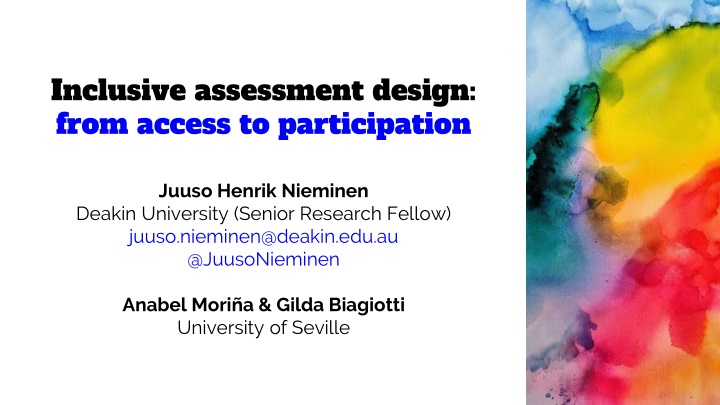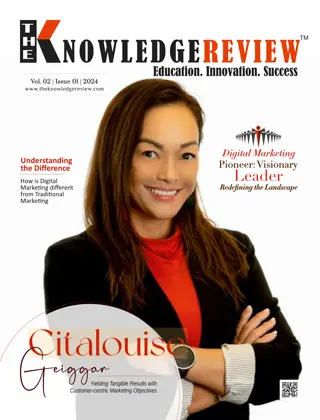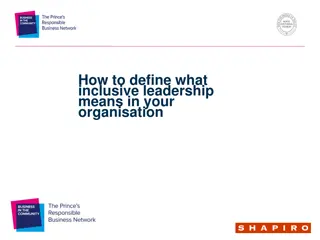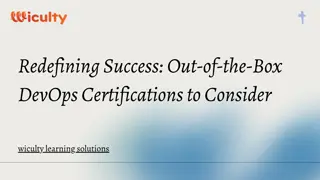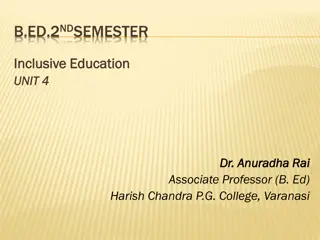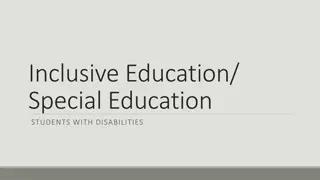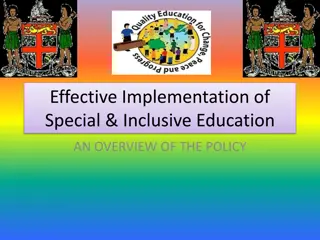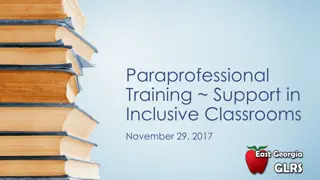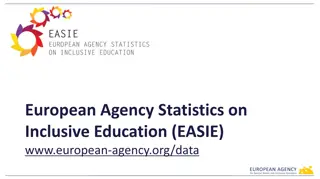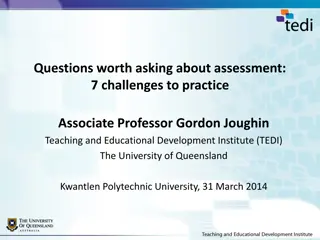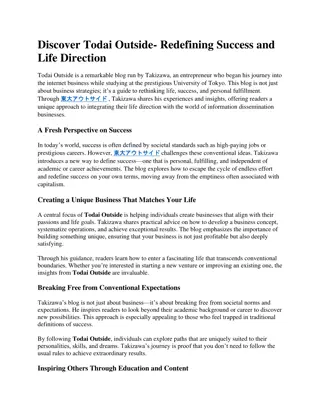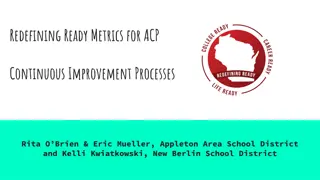Inclusive Assessment: Redefining Higher Education Practices
The discourse on inclusive assessment design in higher education, emphasizing accessibility and participation, challenges traditional norms. Explore how assessment can be redefined to support diverse student populations, especially those with disabilities, fostering a more inclusive learning environment and driving positive change.
Download Presentation

Please find below an Image/Link to download the presentation.
The content on the website is provided AS IS for your information and personal use only. It may not be sold, licensed, or shared on other websites without obtaining consent from the author.If you encounter any issues during the download, it is possible that the publisher has removed the file from their server.
You are allowed to download the files provided on this website for personal or commercial use, subject to the condition that they are used lawfully. All files are the property of their respective owners.
The content on the website is provided AS IS for your information and personal use only. It may not be sold, licensed, or shared on other websites without obtaining consent from the author.
E N D
Presentation Transcript
Inclusive assessment design: from access to participation Juuso Henrik Nieminen Deakin University (Senior Research Fellow) juuso.nieminen@deakin.edu.au @JuusoNieminen Anabel Mori a & Gilda Biagiotti University of Seville
INCLUSION IN HIGHER EDUCATION The universal higher education model has enabled access and widened diversity Yet we have no clear definition of inclusion in this contested space (Nieminen & Pesonen, 2021; Stentiford & Koutsouris, 2021)
THE CASE OF ASSESSMENT Inaccessible assessment is a major barrier for students with disabilities (Brandt, 2011; Edwards et al., 2022; Fuller et al., 2004a, 2004b; Hanafin et al., 2007; Nieminen, 2020, 2021, 2023b; Nieminen & Pesonen, 2020, 2022; Lopez-Gavira & Mori a, 2015; Redpath et al., 2013; Ryan, 2007 ) Reasonable adjustments are provided in legislation, inclusive assessment design is not
Why focus on assessment? Assessment determines what success and abilities look like in higher education as well as their opposites, failure and disabilities Assessment drives learning and defines futures
How could assessment be made more inclusive for a diverse body of studens?
How could assessment be made more inclusive for a diverse body of students? Dilemma stemming from the world of measurement How to assess the students in the margin ? (Russell & Kavanaugh, 2011)
How could assessment be made more inclusive for a diverse body of students? Dilemma stemming from the world of measurement How to assess the students in the margin ? (Russell & Kavanaugh, 2011) Rethinking the dilemma itself Assessment pushes students to the margins (Campbell, 2024)
INCLUSION IN ASSESSMENT? (BAGGER, 2022) Access to assessment Accommodations (...) should be viewed as simply the tools for accessing or demonstrating knowledge, no different than reading glasses. (Cohen et al., 2005, p. 232) University of Toronto, ATS
INCLUSION IN ASSESSMENT? (BAGGER, 2022) Societal participation through assessment Students inclusion as fully accepted members of academic communities? Who does assessment disable, how, and what are the consequences?
Pictures and colours help us dyslexics a lot. Nowadays, I colour-code my materials, particularly if there s much mathematical yarn. I use green, turquoise All the colours are in use. It s much easier to read than just black and white. ( ) An image can be worth more than a thousand words. Y in Nieminen et al., 2024, p. 20 Who is seen as normal and able in assessment? Does assessment provide diverse ways of knowing, being and becoming?
LITERATURE REVIEW How could inclusion be conceptualised in assessment? What kinds of experiences do students with disabilities have about assessment and assessment accommodations? How do these experiences reflect inclusion and exclusion, as understood through Bagger s (2022) conceptualisation of access and participation?
Metaethnography Building theory based on qualitative studies: hearing the student voice Published between 2010-2022 Studies that provided sufficient information about assessment 42 studies, 868 students with disabilities in total; almost completely interview studies An emotionally draining process!
ACCESS: EXPERIENCES OF INCLUSION (22/42) Students largely experienced that testing accommodations provided an access to exams, which promoted inclusion in assessment Some students went as far as saying that extended time has made a profound difference in their academic career. (...) I think it s definitely one of the things in my college career that s helped me the most. Slaughter et al., 2020, p. 9
ACCESS: EXPERIENCES OF EXCLUSION (40/42) Closed-book examinations as the most significant structural barrier (Lewis & Lynn, 2018, p. 14) I wish I could have more breaks during an exam and not have to sit still for 3 hours in front of the computer Anna in Kourea et al. 2021, p. 117
ACCESS: EXPERIENCES OF EXCLUSION (40/42) I had to wait for two months to make a provision of scribe services available in my role book. I made three trips to the main campus of the university to get this done. I was alone and there was no help. Kunnath & Mathew, 2019, p. 180 Issues in accessing assessment adjustments: a troublesome process (Goegan et al., 2020, p. 5)
PARTICIPATION: EXPERIENCES OF INCLUSION (5/42) When I had to go to the physical place, I would see other people also getting extra time and stuff to go have breaks. It was really nice to feel normal, I guess, in that sense. I haven t really felt excluded. Tai et al., 2022, p. 7 Counter-spaces in inaccessible and even discriminatory academia
PARTICIPATION: EXPERIENCES OF INCLUSION (5/42) Through self-assessment you become more aware of the training in mathematics, because just like in any sport, you constantly need to track your own performance. Nieminen & Pesonen, 2020, p. 9 Authentic assessment providing an inclusion for the longer term, beyond the university
PARTICIPATION: EXPERIENCES OF EXCLUSION (24/42!) Sometimes we don t have volunteer readers [in exams] because the sighted students are not ready to be insulted by lecturers. Udoka in Nnama- Okechukwu et al., 2020, p. 7 Outright discrimination: bullying by teachers and fellow students, denial of adjustments Most of the time you are afraid of speaking. They will think that you don t study, you don t care. So it s up to you to keep your fears or fight against them. Stampoltzis et al., 2015, p. 163
PARTICIPATION: EXPERIENCES OF EXCLUSION (24/42!) Stigmatisation and marginalisation: assessment renders certain students as abnormal and unfit It does cause physical separation in that respect. You don t get to do things the way everyone else does. Writing them with extra time and not writing them with class. You can t fix that but it s always a little frustrating because you don t want to be abnormal, you want to be normal. You want to fit with the rest of the class. Terry in Ertem, 2011, p. 108
PARTICIPATION: EXPERIENCES OF EXCLUSION (24/42!) Do you think it is actually a good thing sticking someone in an exam room for 3-hours anyway whether they are disabled or not? C mon. Think about it! Alan in Madriaga & Goodley, 2010, p. 124 Inauthentic assessment as a barrier for participating in the society
CONCLUSION: ASSESSMENT AS A MATTER OF INCLUSION So far, we have conceptualised assessment as a way of measuring learning objectives In doing so, we have neglected the social effects of assessment in good and bad! Every assessment situation regulates students experiences of inclusion/exclusion
CONCLUSION: ASSESSMENT AS A MATTER OF INCLUSION Inclusion in assessment is a matter of access and participation At the moment, inclusive assessment practices and policies predominantly focus on accessibility We need to understand the deeper aspects of inclusion in assessment
CONCLUSION: ASSESSMENT AS A MATTER OF INCLUSION The big question for future research and practice: We can never forget the importance of access! However, how could we ensure assessment also promotes participation of traditionally marginalised students?
THANK YOU! Interested in some of these ideas? Let s collaborate! DR. JUUSO HENRIK NIEMINEN juuso.nieminen@deakin.edu.au juusonieminen.com @JuusoNieminen
HOW TO MOVE FURTHER? SOME THOUGHTS Rethinking the assessment adjustment model Anti-ableist work in and beyond assessment Student partnership Centring human diversity in assessment Interdependence rather than individualism 1. 2. 3. 4. 5.
References Bagger, A. (2022). Opportunities to display knowledge during national assessment in mathematics: a matter of access and participation. European Journal of Special Needs Education, 37(1), 104-117. Brandt, S. (2011). From policy to practice in higher education: The experiences of disabled students in Norway. International Journal of Disability, Development and Education, 58(2), 107-120. Campbell, P. I. (2024). Pray (ing) the person marking your work isn't racist : racialised inequities in HE assessment practice. Teaching in Higher Education, 29(5), 1166-1180. Cohen, A. S., Gregg, N., & Deng, M. (2005). The role of extended time and item content on a high stakes mathematics test. Learning Disabilities Research & Practice, 20(4), 225-233. Edwards, M., Poed, S., Al-Nawab, H., & Penna, O. (2022). Academic accommodations for university students living with disability and the potential of universal design to address their needs. Higher education, 84(4), 779-799. Erten, O. (2011). Facing Challenges: Experiences of Young Women with Disabilities Attending a Canadian University. Journal of Postsecondary Education and Disability, 24(2), 101-114. Fuller, M., Bradley, A., & Healey, M. (2004). Incorporating disabled students within an inclusive higher education environment. Disability & society, 19(5), 455-468. Fuller*, M., Healey, M., Bradley, A., & Hall, T. (2004). Barriers to learning: a systematic study of the experience of disabled students in one university. Studies in higher education, 29(3), 303-318. Goegan, L. D., Le, L., & Daniels, L. M. (2023). Online learning is a rollercoaster: Postsecondary students with learning disabilities navigate the COVID-19 pandemic. Learning Disability Quarterly, 46(3), 166-179. Hanafin, J., Shevlin, M., Kenny, M., & Neela, E. M. (2007). Including young people with disabilities: Assessment challenges in higher education. Higher education, 54, 435-448. Kourea, L., Christodoulidou, P., & Fella, A. (2021). Voices of undergraduate students with disabilities during the COVID-19 pandemic. European Journal of Psychology Open. Kunnath, S. K., & Mathew, S. N. (2019). Higher education for students with disabilities in India: Insights from a focus group study. Higher Education for the Future, 6(2), 171-187. Lewis, K. E., & Lynn, D. M. (2018). Access through compensation: Emancipatory view of a mathematics learning disability. Cognition and Instruction, 36(4), 424-459. L pez Gavira, R., & Mori a, A. (2015). Hidden voices in higher education: Inclusive policies and practices in social science and law classrooms. International Journal of Inclusive Education, 19(4), 365-378.
References (cont.) Madriaga, M., & Goodley, D. (2010). Moving beyond the minimum: Socially just pedagogies and Asperger s syndrome in UK higher education. International Journal of Inclusive Education, 14(2), 115-131. Nnama-Okechukwu, C. U., Chukwuka, P. N., & Okoye, U. O. (2020). Challenges with institutional support services for undergraduate students with visual impairment in University of Nigeria Nsukka. Journal of Evidence-Based Social Work, 17(6), 677-695. Nieminen, J. H. (2024). Assessment for Inclusion: rethinking inclusive assessment in higher education. Teaching in Higher Education, 29(4), 841-859. Nieminen, J. H. (2023). A spanner in the works: The portrayal of disabled students in assessment adjustment research. International Studies in Sociology of Education, 32(1), 30-55. Nieminen, J. H., Reinholz, D. L., & Valero, P. (2024). Mathematics is a battle, but I ve learned to survive : becoming a disabled student in university mathematics. Educational Studies in Mathematics, 116(1), 5-25. Nieminen, J. H. (2023). Unveiling ableism and disablism in assessment: A critical analysis of disabled students experiences of assessment and assessment accommodations. Higher Education, 85(3), 613-636. Nieminen, J. H., & Pesonen, H. V. (2022). Politicising inclusive learning environments: how to foster belonging and challenge ableism?. Higher Education Research & Development, 41(6), 2020-2033. Nieminen, J. H., & Pesonen, H. V. (2019). Taking universal design back to its roots: Perspectives on accessibility and identity in undergraduate mathematics. Education Sciences, 10(1), 12. Redpath, J., Kearney, P., Nicholl, P., Mulvenna, M., Wallace, J., & Martin, S. (2013). A qualitative study of the lived experiences of disabled post-transition students in higher education institutions in Northern Ireland. Studies in Higher Education, 38(9), 1334-1350. Russell, M., & Kavanaugh, M. (2011). Assessing students in the margins. Charlotte, NC: Information Age Publishing. Ryan, J. (2007). Learning disabilities in Australian universities: Hidden, ignored, and unwelcome. Journal of Learning Disabilities, 40(5), 436-442. Slaughter, M. H., Lindstrom, J. H., & Anderson, R. (2022). Perceptions of extended time accommodations among postsecondary students with disabilities. Exceptionality, 30(4), 246-260. Stampoltzis, A., Tsitsou, E., Plesti, H., & Kalouri, R. (2015). The Learning Experiences of Students with Dyslexia in a Greek Higher Education Institution. International Journal of Special Education, 30(2), 157-170. Stentiford, L., & Koutsouris, G. (2021). What are inclusive pedagogies in higher education? A systematic scoping review. Studies in Higher Education, 46(11), 2245- 2261. Tai, J., Mahoney, P., Ajjawi, R., Bearman, M., Dargusch, J., Dracup, M., & Harris, L. (2023). How are examinations inclusive for students with disabilities in higher education? A sociomaterial analysis. Assessment & Evaluation in Higher Education, 48(3), 390-402.
